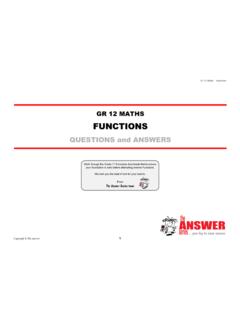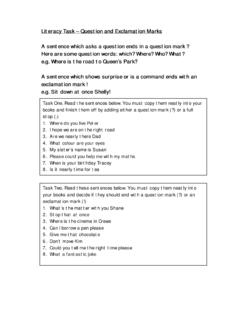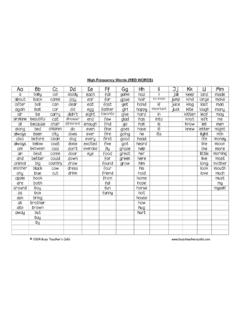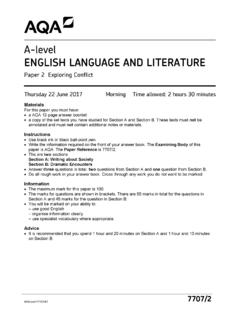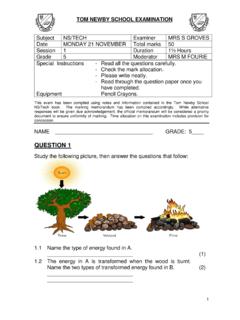Transcription of GR 12 PHYSICAL SCIENCES EXAM QUESTION …
1 GR 12 physical sciences exam question PAPERS & MEMOS Exam QUESTION Papers Paper 1 (Physics) .. 1 Paper 2 (Chemistry) .. 4 Exam Memos Exam Memo 1 (Physics) .. 8 Exam Memo 2 (Chemistry) .. 11 Formula Sheets .. 14 We trust that working through these exam papers and following our suggested answers and comments will help you prepare thoroughly for your final exam. The Answer Series PHYSICAL SCIENCES study guides offer a key to exam success. 1 Copyright The Answer E EXAM PAPERS 1 EXAM QUESTION PAPERS PAPER 1 National Nov 2013 - Adapted for CAPS QUESTION 1 Four options are provided as possible answers to the following questions.
2 Each QUESTION has only ONE correct answer. Write only the letter (A - D) next to the QUESTION numbers ( - ). Which ONE of the following PHYSICAL quantities is equal to the product of force and constant velocity? A work B power C energy D acceleration (2) A 30 kg iron sphere and a 10 kg aluminium sphere with the same diameter fall freely from the roof of a tall building. Ignore the effects of friction. When the spheres are 5 m above the ground, they have the same .. A momentum B acceleration C kinetic energy D potential energy (2) The free-body diagram below shows the relative magnitudes and directions of all the forces acting on an object moving horizontally in an easterly direction.
3 The kinetic energy of the object .. A is zero B increases C decreases D remains constant (2) The hooter of a vehicle travelling at constant speed towards a stationary observer, produces sound waves of frequency 400 Hz. Ignore the effects of wind. Which ONE of the following frequencies, in hertz, is most likely to be heard by the observer? A 400 B 350 C 380 D 480 (2) An astronomer, viewing light from distant galaxies, observes a shift of spectral lines toward the red end of the visible spectrum. This shift provides evidence that.
4 A the universe is expanding. B the galaxies are moving closer towards Earth. C Earth is moving towards the distant galaxies. D the temperature of Earth's atmosphere is increasing. (2) When light of a certain frequency is incident on the cathode of a photocell, the ammeter in the circuit registers a reading. The frequency of the incident light is now increased while keeping the intensity constant. Which ONE of the following correctly describes the reading on the ammeter and the reason for this reading?
5 Ammeter reading Reason A increases More photoelectrons are emitted per second. B increases The speed of the photoelectrons increases. C remains the same The number of photo-electrons remains the same. D remains the same The speed of the photo-electrons remains the same. (2) Which ONE of the following graphs best represents the relationship between the electrical power and the current in a given ohmic conductor? A B C D (2) In a vacuum, all electromagnetic waves have the same .. A energy B speed C frequency D wavelength (2) incident lightmetal surfacee- APIPI PIPI NESW normal forceapplied force frictionalforce weightPhysical SCIENCES is easier than you thought!
6 The Answer Series offers excellent material for PHYSICAL SCIENCES (Gr 10 - 12). Visit our website Copyright The Answer 2 E EXAM PAPERS 1 In the sketch alongside, a conductor carrying conventional current, I, is placed in a magnetic field. Which ONE of the following best describes the direction of the magnetic force experienced by the conductor? A parallel to the direction of the magnetic field B opposite to the direction of the magnetic field C into the page perpendicular to the direction of the magnetic field D out of the page perpendicular to the direction of the magnetic field (2) An atom in its ground state absorbs energy E and is excited to a higher energy state.
7 When the atom returns to the ground state, a photon with energy .. A E is absorbed. B E is released. C less than E is released. D less than E is absorbed. (2) [20] QUESTION 2 A light inelastic string connects two objects of mass 6 kg and 3 kg respectively. They are pulled up an inclined plane that makes an angle of 30 with the horizontal, with an applied force of magnitude F. Ignore the mass of the string. The coefficient of kinetic friction for the 3 kg object and the 6 kg object is 0,1 and 0,2 respectively. State Newton's Second Law of Motion in words.
8 (2) How will the coefficient of kinetic friction be affected if the angle between the incline and the horizontal increases? Write down only increases, decreases or remains the same. (1) Draw a labelled free-body diagram indicating all the forces acting on the 6 kg object as it moves up the inclined plane. (2) Calculate the tension in the string if the system accelerates up the inclined plane at 4 (5) [10] QUESTION 3 A ball of mass 0,15 kg is thrown vertically downwards from the top of a building to a concrete floor below.
9 The ball bounces off the floor. The velocity-time graph below shows the motion of the ball. Ignore the effects of air friction. Take downward motion as positive. From the graph, write down the magnitude of the velocity at which the ball bounces off the floor. (1) Is the collision of the ball with the floor elastic or inelastic? Refer to the data on the graph to explain the answer. (3) Calculate the: height from which the ball is thrown (4) magnitude of the impulse imparted by the floor on the ball (3) magnitude of the displacement of the ball from the moment it is thrown until time t (4) Sketch a position-time graph for the motion of the ball from the moment it is thrown until it reaches its maximum height after the bounce.
10 Use the floor as the zero position. Indicate the following on the graph: The height from which the ball is thrown Time t (4) [19] QUESTION 4 A boy on ice skates is stationary on a frozen lake (no friction). He throws a package of mass 5 kg at 4 m s-1 horizontally east as shown below. The mass of the boy is 60 kg. At the instant the package leaves the boy's hand, the boy starts moving. In which direction does the boy move? Write down only east or west. (1) Which ONE of Newton's laws of motion explains the direction in which the boy experiences a force when he throws the package?

